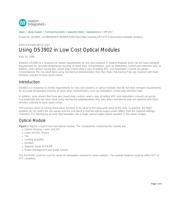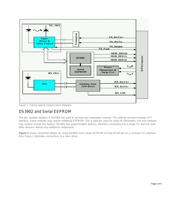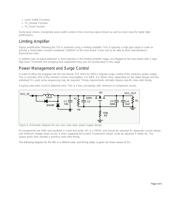herunterladen

Maxim > Design Support > Technical Documents > Application Notes > Optoelectronics > APP 3257
Keywords: DS3902, DS1859,MAX3736,MAX3740,Fiber,Fiber modules,SFP,SFF,Transceivers,Variable resistors,
APPLICATION NOTE 3257
Using DS3902 in Low Cost Optical Modules
Aug 24, 2004
Abstract: DS3902 is a response to market requirements for low cost solutions in Optical Modules which do not have stringent
requirements for accurate temperature tracking of some laser characteristics; such as modulation current and extinction ratio. In
addition, laser drivers having two closed loop control need a way of setting APC and modulation currents set points.
Conventionally this has been done using mechanical potentiometers first, then these mechanical Pots are replaced with fixed
resistors selected to have equal values.
Introduction
DS3902 is a response to market requirements for low-cost solutions in optical modules that do not have stringent requirements
for accurate temperature tracking of some laser characteristics, such as modulation current and extinction ratio.
In addition, laser drivers that have two closed-loop controls need a way of setting APC and modulation currents set points.
Conventionally this has been done using mechanical potentiometers first, then these mechanical pots are replaced with fixed
resistors selected to have equal values.
This process relies on having fixed-value resistors to be close to the measured value of the pots. In practice, the fixed
resistors do not match the pot values and the end result is that the optical-output power differs from the required settings.
Therefore, it is introducing an error that translates into a larger optical-output power variation in the power budget.
Optical Module
Figure 1 depicts a typical low-cost optical module. The components comprising the module are:
Optical Devices, Laser, and PD
Laser /VCSEL Drivers
TIA
Limiting Amplifier
DS3902
Optional Serial EEPROM
Power Management and Surge Control
The EEPROM could be used for serial ID information required in some modules. The module footprint could be either SFF or
SFP compliant.
Page 1 of 5







